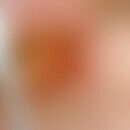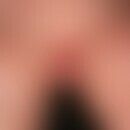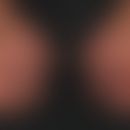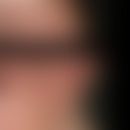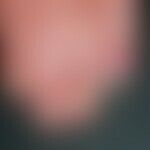Synonym(s)
DefinitionThis section has been translated automatically.
Protracted chronic paronychia, usually caused by Candida albicans.
ManifestationThis section has been translated automatically.
Preferably occurring in adults. Women are affected three times more frequently than men. About 3/4 of cases occur on the index or middle finger. Predisposing factors are working in a moist environment and working with carbohydrates. Other important predisposing factors are hyperhidrosis, acrocyanosis, immunodeficiencies and diabetes mellitus. Injuries to the cuticle, e.g. excessive nail manicure, can allow the yeasts to penetrate under the proximal nail wall and multiply here.
You might also be interested in
LocalizationThis section has been translated automatically.
About 3/4 of the cases occur on the index or middle finger.
ClinicThis section has been translated automatically.
Chronic, usually moderately painful redness and swelling of the nail fold. The cuticle loses its adhesion to the nail plate, allowing foreign bodies to penetrate, and is often completely absent. Bacterial superinfections often occur. Under pressure or spontaneously, thick white material consisting of horn components, pus and fungal elements can be discharged from the nail pocket.
See also Onychia candidosa, candidiasis.
If it persists for a longer period of time, growth disorders with thickening, discoloration and surface corrugation as well as onycholysis of the nail plate may occur.
Candida onychomycosis is possible in this constellation.
Differential diagnosisThis section has been translated automatically.
- Paronychia and onychodystrophy due to dermatophytes: onychomycosis usually persisting for months, secondary infestation of the paronychium; detection of the pathogens
- Bacterial paronychia: usually highly acute, detection of the pathogens
- Acrodermatitis continua suppurativa: eminently chronic, pustular dermatitis, usually not limited to the nail wall
Complication(s)(associated diseasesThis section has been translated automatically.
A green-black discoloration of the nail plate, especially in its lateral part, is often an indication of an accompanying bacterial infection caused by moist germs such as Pseudomonas aeruginosa or Klebsiella.
General therapyThis section has been translated automatically.
If possible, compensate for predisposing factors (e.g. immunodeficiencies, diabetes mellitus, acrocyanosis, hyperhidrosis, change of occupation if necessary in bakery professions, nursing, etc.).
External therapyThis section has been translated automatically.
In the case of mycotic infestation of the nail, nail bed and nail wall, surgical removal of the nail is recommended; the infection will heal promptly. An attempt at treatment with an antifungal nail varnish (e.g. Loceryl nail varnish; Amorolfin) may be useful. In the case of uncomplicated paronychia (nail and nail bed are free), careful antimycotic local therapy with a broad-spectrum antimycotic such as amorolfine as a nail varnish/cream (e.g. Loceryl) or bifonazole (e.g. Mycospor), followed by a thick layer of cream or ointment. Apply dressing, if necessary occlusion for hours with rubber finger cots.
Regular prophylactic hand disinfection (e.g. disinfectant spirit (NRF 11.27.)). No cutting of the cuticle. In case of injuries to the nail wall, consistent antiseptic local therapy (e.g. with povidone-iodine ointment, R204). Hand-warm soap baths, 5-10 minutes, preferably with curd soap, but also liquid soaps have proven effective. The bath water should appear milky and cloudy.
Internal therapyThis section has been translated automatically.
In complicated paronychia (mycotic nail infection), itraconazole (e.g. Sempera) has proved effective, dosage: 100 mg/day p.o. until healing or as interval therapy 2x/day 200 mg over 7 days, 3 weeks break and repetition of the cycle a further two times.
Alternatively: Fluconazole (e.g. Diflucan Derm) 50 mg/day p.o. until healing.
LiteratureThis section has been translated automatically.
- Crawford F et al (2002) Oral treatments for toenail onychomycosis: a systematic review. Arch Dermatol 138: 811-816
- Ellis DH (1999) Diagnosis of onychomycosis made simple. J Am Acad Dermatol 40: S3-S8
- Gupta AK et al (2003) Non-dermatophyte onychomycosis. Dermatol Clin 21: 257-268
- Gupta AK et al (2000) Itraconazole pulse therapy for the treatment of Candida onychomycosis. J Eur Acad Dermatol Venereol 15: 112-115
- Hay RJ (1999) The management of superficial candidiasis. J Am Acad Dermatol 40: S35-S42
Incoming links (6)
Amphotericin b; Candida onychomycosis; Chronic mucocutaneous candidiasis; Disinfectant spirit (nrf 11.27.); Paronychia chronic; Povidone-iodine ointment 10%, hydrophilic, soft (nrf 11.17.);Outgoing links (16)
Acrocyanosis; Acrodermatitis continua suppurativa; Amorolfin; Bifonazole; Candida onychomycosis; Candidoses; Cream; Disinfectant spirit (nrf 11.27.); Fluconazole; Hyperhidrosis (overview); ... Show allDisclaimer
Please ask your physician for a reliable diagnosis. This website is only meant as a reference.

